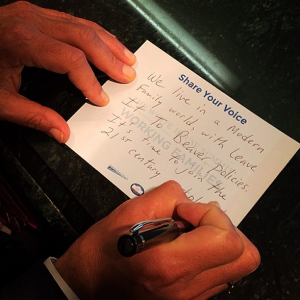The White House has been hosting Summits on Working Families across the country with the “focus on how we can strengthen our nation’s workplaces to better support working families, boost businesses’ bottom lines, and ensure America’s global economic competitiveness in the coming decades.” Recently, a summit in Washington, DC brought hundreds of participants from labor and nonprofit organizations, businesses, elected officials and citizens who came together to talk about how to build a workforce and a workplace that meet the needs of today.
The Working Families Summit presented some facts on how our workforce has changed:
“Just as the makeup of the typical American family has shifted, so has the dynamic of our workforce. Women, particularly mothers, have increasingly entered the workforce and now make up roughly half of all workers in the United States. Only 27 percent of mothers were breadwinners or co-breadwinners in American families in 1967. Fast forward to 2011, and nearly two-thirds of mothers are breadwinners or co-breadwinners….”
Unfortunately, our laws and workplaces haven’t kept up with these changes. Women still earn less than men, and most Americans lack flexibility at work to meet their family needs without paid family leave.
The Latino population is a continual source of scrutiny for demographic trends within the United States, and stats on the working families of this community are not exempt. While conditions have changed in the last decades for the better, Latino working families still face many obstacles to succeed.
Here are 10 Facts about Latino Working Families in the United States:
23 million
Latinos made up 15 percent of the US labor force in 2011 (nearly 23 million), and it is expected to increase to 19 percent by 2020.
$50,000
“Among all U.S. Hispanic households, nearly 40% earn greater than $50,000 in household income.” Those who owned a business, earn even more. “Nearly 30% of Hispanics who identify themselves as small business owners earn more than $100,000. Comparatively, 20% of all U.S. households earn more than $100,000 in annual household income.”
2 in 5
Latinas comprised 41 percent of all Latinos working in 2011 compared to the national overall 47 percent of women working in the US. This is nearly a double rate since 1975.
52%
52 percent of children in immigrant Latino families live with at least one householder with a high school diploma, compared to 80 percent in US-born Latino families. Latinos continue to earn fewer college degrees compared to whites. “Between 2000 and 2011, the gap between employed Whites with a college education and employed Latinos with a college education grew from 17.6 percentage points to 20.1 percentage points.”
2 in 3
Two thirds (66%) of Latino households are married-couple families (77% for US-born Latino families compared to 88% for immigrant Latino families) and 41 percent of these have children under the age of 18. There was 23 percent of Latinos under 18 in 2009.
71 cents
A Latino employee earns 71 percent of that earned by whites. On average, women still earn 77 percent for every dollar earned by men. Latinas make 80 percent of the earnings of Latino men and 59 percent of the annual earnings of white men.
3 in 4
Three in four Latinos are US citizens (74%) and just over a third are foreign-born (37.3%). There are an estimated 5.5 million children with at least one undocumented parent, 4.5 million of whom were born here, making them U.S. citizens (not all Latinos though).
83%
Latinos are more likely to work in the private sector (83 percent) than whites and African Americans (78.5% & 76.9 respectively).
85.1
85.1 percent of Latino families had at least one member employed full or part-time in 2013. Only in 20.1 percent of Latino married couples, men were the only breadwinners whereas both adults worked in 59 percent of married Latino couples. There are 2 million households led by Latinas. Latinos continue to face higher levels of unemployment compared to the national unemployment rate.
$38,039
In 2009, the Latino median-household income was less than the white household median, $38,039 to $54,461 respectively. Overall, Latinos only held 2.2 percent of wealth in the United States.
“Families cannot get ahead if we are stuck with policies and workplaces from the ‘Mad Men’ era. It’s no longer 1960,” the White House writes. Indeed, if we want all our families to succeed, we must confront what is keeping many of our families behind. These quick facts about Latino working families also show the need for more comprehensive policies that live up to the needs of our families. Addressing the pay gaps, passing immigration reform, family-paid leave, better educational outcomes, workplace flexibility, protecting workers’ rights and ensuring workplace safety are some of the things our families need to continue to build on decades of progress and succeed.

